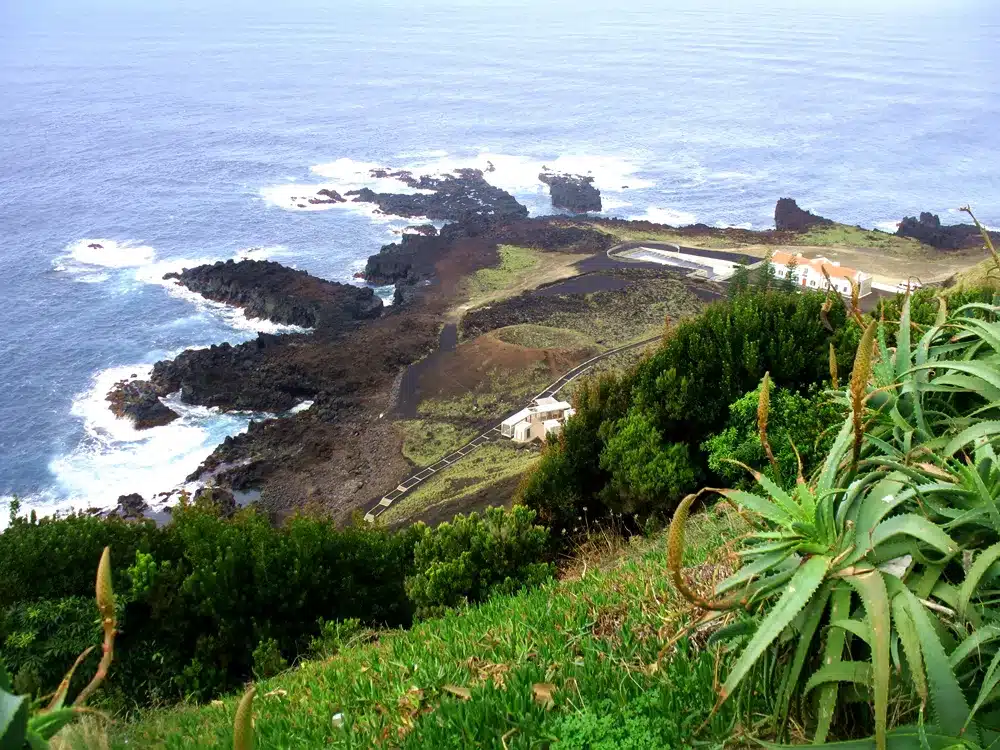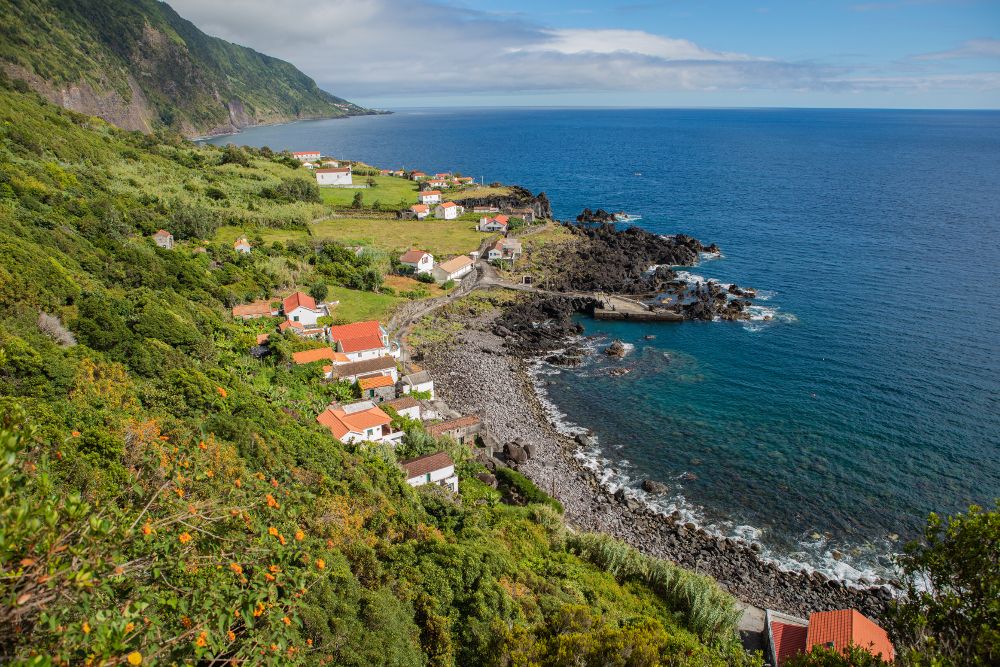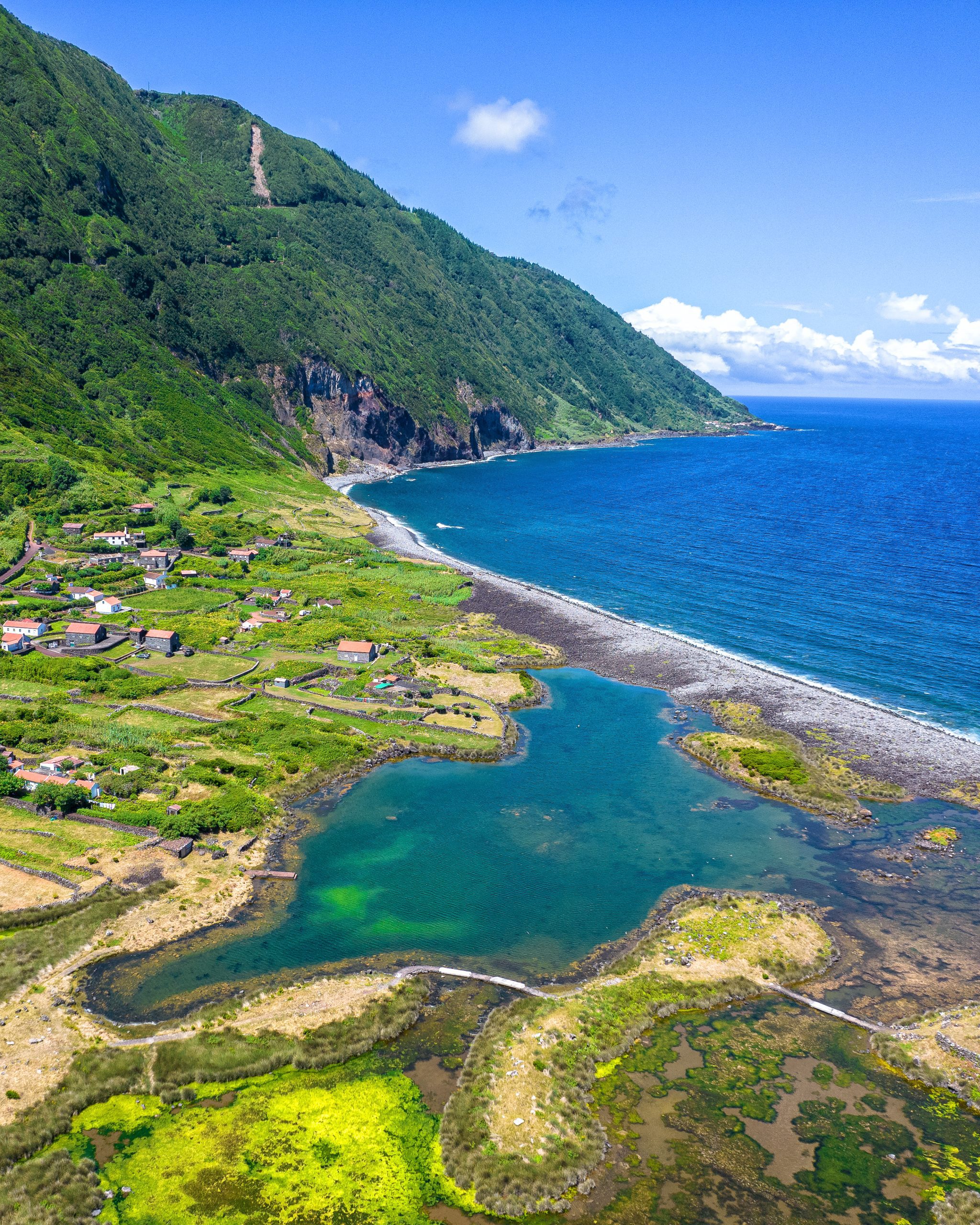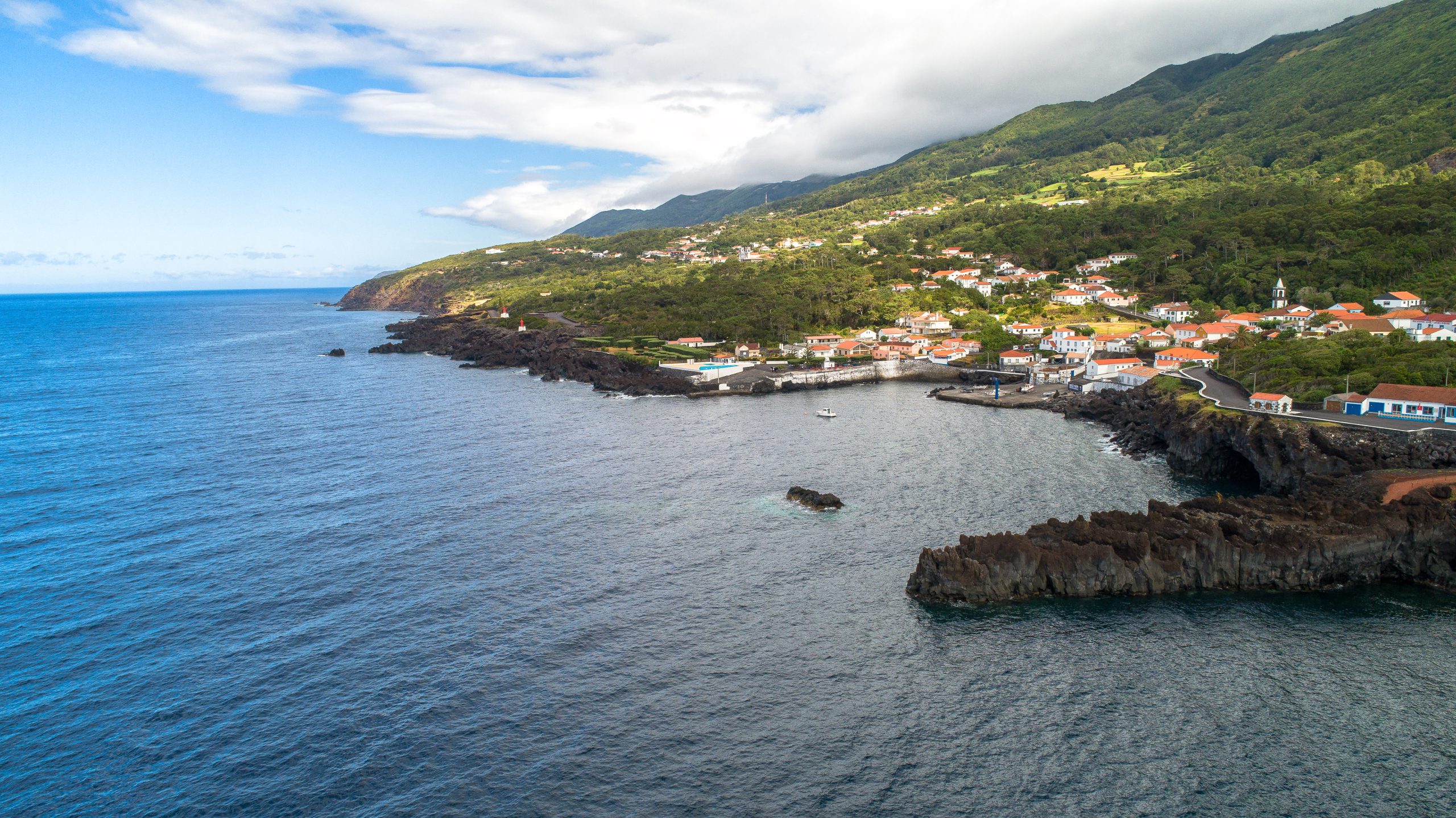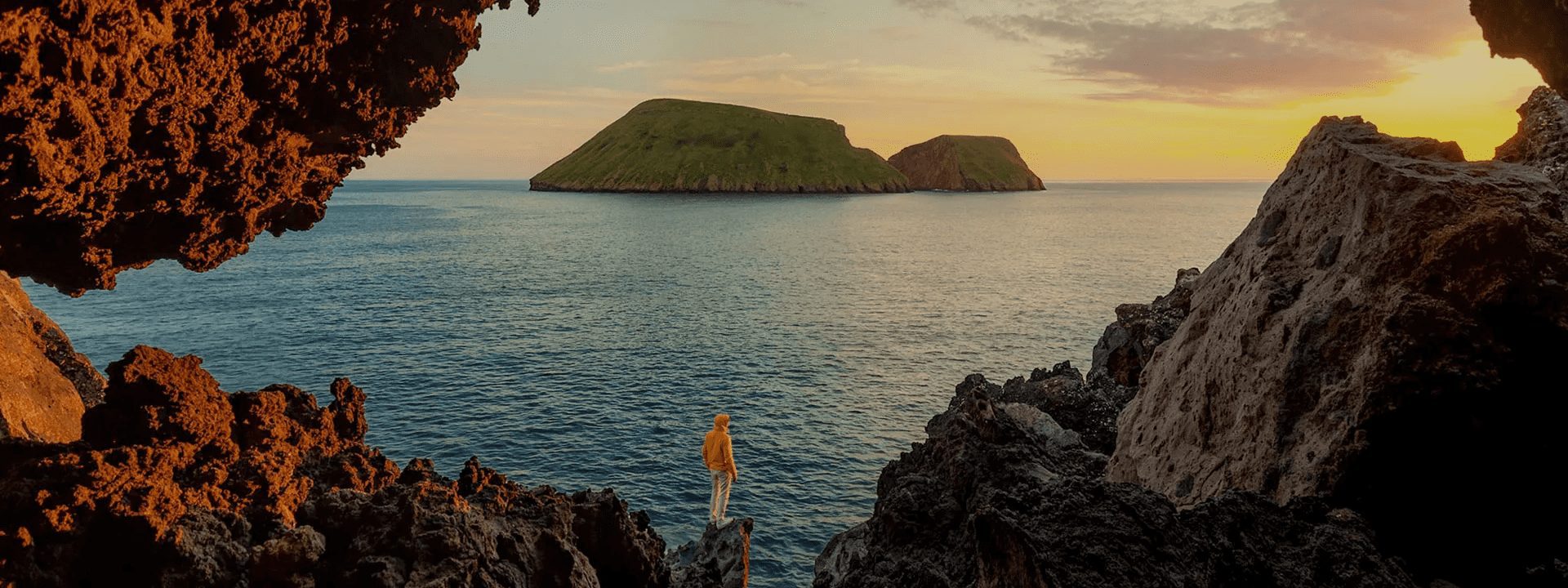Find out more about Fajã dos Vimes, a small fishing village on São Jorge Island in the Azores. This region is renowned for its stunning geographical features and strong history. Visitors are guaranteed to enjoy a combination of activities and leisure time. Whether you are hiking through the forest, tasting Azorean coffee, or learning about the culture, you are sure to have a great time. This is your guide to the best of what this little piece of paradise has to offer.
What is a Fajã

Fajãs are coastal plains made of landslides or solidified lava. These unique geographical formations are particularly well known in São Jorge, where they combine rich biodiversity with stunning landscapes.
Fajã dos Vimes is not only a destination, but also an experience that includes nature, culture, and particular traditions. It’s time to plan your trip to Fajã dos Vimes and find out why this historical village should be at the top of your Portugal travel list.
Historic & Geographic
Fajã dos Vimes in Ribeira Seca is one of the largest Fajãs on São Jorge Island in the Azores. This coastal plain is bordered by a cliff about 400 meters high and is characterized by its high rainfall and cultural density.
Traditionally, the local economy was based on subsistence agriculture, where people grew crops to feed themselves. The main products included coffee and yams, as well as the handmade production of the famous São Jorge rugs. Fajã dos Vimes was totally wiped out by an earthquake in 1757. As an elementary community living under the Count of Aveiras’ ownership, the people rebuilt their houses and the religious sanctuary.
Presently, tourists to Fajã dos Vimes can stroll through the streets, observe coffee cultivation, and witness artisans using over a century-old looms. This fajã remains, to this date, a prime example of the island’s cultural and agricultural identity. Visiting this place is an authentic experience.
Why Visit Fajã dos Vimes

The village of Fajã dos Vimes has a very vibrant cultural heritage. It is one of the few coffee plantations in Europe. Visitors can enjoy homemade coffee, cultivated without the use of chemicals, accompanied by a breathtaking view of the Atlantic Ocean. Also, the region’s handwoven blankets reveal the rich history of the Azores’ artisans.
Tourists can observe weavers at work, learning about the local art of weaving, and take home a souvenir that represents the place’s heritage. This, along with all the activities visitors can experience here, makes this location a hidden gem not to be missed when visiting São Jorge Island.
What to Do in Fajã dos Vimes

Hiking and Nature
This location in São Jorge is perfect for adventurous visitors. You can enjoy trails across lush landscapes, incredible waterfalls, and fantastic panoramic viewpoints. For those who want to come into direct contact with nature, the trail that joins the fajã with other parts of the island is perfect.
Relaxation and Crystal Waters
If you prefer to relax, use your surroundings to experience tranquil coves for a refreshing swim in the crystal-clear waters or to hear the sound of the waves in a true paradise.
Unique Culture
Drinking coffee in Fajã dos Vimes is a unique and rare experience. Visitors can savor artisanal coffee with a distinctive and authentic flavor while taking in the magical views of the Atlantic. I recommend trying it at Café Nunes. Additionally, visitors can witness the traditional weaving process and take home a unique piece symbolizing the local culture.
Plan Your Visit to Fajã dos Vimes

How to Get to Fajã dos Vimes
It is accessible by a road that runs along the island’s slopes in a scenic route. The best option is to rent a car and visit at your own pace, though keep an eye out for sharp curves. You can also take guided tours.
Planning a trip to the Azores? These articles will help you: How to Get to the Azores 🗺️ | Azores airports 🛬 | Flights between islands ✈️ | Ferries between islands ⛴️ | Which island to choose? 🏝️ | What airlines fly to the Azores? 🛩️
Where to Eat
Click on the following link to find a place to eat near Fajã dos Vimes. It will take you to TripAdvisor, where you can review the 10 best restaurants.
Where to Stay
Looking for the perfect place to stay? We’ve made it easy by filtering top accommodation options from Airbnb, Booking, and Tripadvisor. Here, you’ll find the ideal place to stay and enjoy your visit!
Pro Tips
- Best time to visit: During spring and summer, you can expect milder weather and clearer views. The trails are also in ideal conditions for exploration during these seasons.
- Duration of visit: Set aside at least half a day to explore the fajã at a leisurely pace, but I recommend you prepare a whole day to enjoy all the experiences thoroughly.
Nearby Attractions
Check all our articles about each one of the most relevant points of interest on São Jorge Island: Fajã das Almas | Fajã dos Cubres | Fajã de Santo Cristo | Fajã do Ouvidor | Fajã dos Vimes | Urzelina
Complementary Information
Best Season to Visit the Azores
The Azores Archipelago boasts a unique climate that shapes its lush landscapes, making it a splendid year-round destination. With mild temperatures and minimal fluctuations, each season offers something unique. Spring averages 16 °C, summer reaches 21 °C, autumn cools to 18 °C, and winter remains mild at 14 °C.
→ For a detailed breakdown of the weather by month, check the following links 🌤️☔️: January | February | March | April | May | June | July | August | September | October | November | December
How to Get to the Azores
The Azorean Archipelago is easily accessible through numerous flight routes. Lisbon and Porto are the main entry points to the continent, with direct flights available to São Miguel (PDL), Terceira (TER), Faial (HOR), Pico (PIX), and Santa Maria (SMA). To find the best flight, use search engines like eDreams or Skyscanner. These platforms enable you to compare prices and schedules from various airlines in one convenient location.
For more details on how to get to the Azores, take a look at our complete guide. But what if you want to explore beyond your arrival island? We’ve got you covered!
- Azores airports 🛬
- Flights between islands ✈️
- Ferries between islands ⛴️
- Which island to choose? 🏝️
- What airlines fly to the Azores? 🛩️
→ Once you’ve found the perfect route, book your tickets and get ready to experience one of the world’s most stunning island groups!
Travel Essentials
Essential Information for your Azores trip: Azorean Language & Phrases 🗣️ | Currency & Banks 💵 | Credit Cards & Traveler’s Cheques 🏧 | Driving in the Azores 🚗 | Electricity 🔌 | Experiences & Tours 🗺️ | Health & Safety 🩺 | Internet & Wi-Fi Access 🛜 | Phones & Mobile Service 📞 | Post Offices & Buying Stamps ✉️ | Public Holidays 🏖️ | Shopping 🛒 | Time & Daylight 🕒 | Whale Watching Guide 🐳 | Best Island to Visit 🏞️
Useful Tools & Apps
The weather in the Azores can be variable, so it’s helpful to use some apps before visiting the islands. Spotazores provides live camera feeds from the main tourist attractions, allowing you to check the weather and plan your visit. For accurate weather predictions, use Windy or Windguru — they provide the most reliable predictions.
Video
Conclusion
Fajã dos Vimes is not only a place to visit, but also a destination that offers a unique blend of nature, culture, and tradition. From beautiful treks, fabulous coffee, handmade artifacts, and maritime cultural traditions, this is the ideal Azorean retreat for anyone looking to immerse themselves in the essence of this island.
Authors’ Note
I am pleased to inform you that all the recommendations in this article are based on my personal experience and observations. As the author, I have personally visited each attraction mentioned, ensuring that every suggestion is grounded in first-hand knowledge and genuine enthusiasm.
FAQs
The best time to visit is during spring and summer when the weather is mild, and the views are at their clearest.
Yes, there are local inns and rural accommodations that offer authentic stays and regional breakfasts.
The fajã is accessible via a scenic road. While the drive requires caution due to sharp curves, the views along the way make it worthwhile.
Visitors can enjoy hiking trails, explore serene coves, experience local crafts, and sample artisanal coffee.
Absolutely! Fajã dos Vimes offers activities for all ages, including nature walks, beach relaxation, and cultural experiences.





